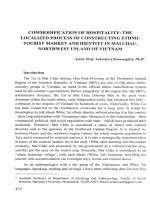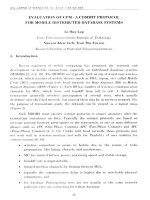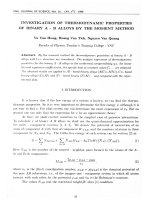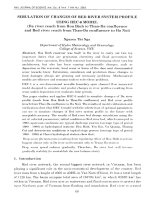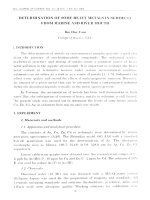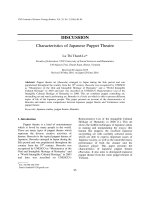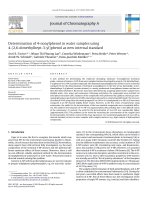DSpace at VNU: Control of preferred (222) crystalline orientation of sputtered indium tin oxide thin films
Bạn đang xem bản rút gọn của tài liệu. Xem và tải ngay bản đầy đủ của tài liệu tại đây (1.36 MB, 4 trang )
Thin Solid Films 570 (2014) 16–19
Contents lists available at ScienceDirect
Thin Solid Films
journal homepage: www.elsevier.com/locate/tsf
Control of preferred (222) crystalline orientation of sputtered indium tin
oxide thin films
Duy Phong Pham a, Bach Thang Phan a,b, Van Dung Hoang a, Huu Truong Nguyen a, Thi Kieu Hanh Ta b,
Shinya Maenosono c, Cao Vinh Tran a,⁎
a
b
c
Laboratory of Advanced Materials, University of Science, Vietnam National University, Ho Chi Minh, Viet Nam
Faculty of Materials Science, University of Science, Vietnam National University, Ho Chi Minh, Viet Nam
Japan Advanced Institute of Science and Technology, Nomi, Ishikawa, Japan
a r t i c l e
i n f o
Article history:
Received 18 February 2014
Received in revised form 30 July 2014
Accepted 29 August 2014
Available online 9 September 2014
Keywords:
Indium tin oxide
Thin films
Texture
Conductivity
Surface roughness
Sputtering
a b s t r a c t
We report a two-step growth process for the fabrication of (222)-plane textured indium tin oxide (ITO) films. A
thin ITO seed layer was grown in mixed Argon + Oxygen gases, followed by a thick ITO deposited in Argon gas.
X-Ray diffraction shows that the sputtered ITO films exhibit strongly preferred (222) crystalline orientation. The
(222)-plane textured ITO films have high transmittance above 80% in the visible range and carrier concentration,
mobility and resistivity in the range of 1021 cm−3, 40 cm2/Vs and 10−4 Ω·cm, respectively. The surface roughness of our (222) textured ITO films is 1.4 nm, which is one of the smallest value obtained from sputtered ITO
thin films.
© 2014 Elsevier B.V. All rights reserved.
1. Introduction
Tin-doped indium oxide (ITO) has been known as a transparent
electrode in several optoelectronic devices such as liquid crystal displays, solar cells, organic light-emitting diodes (OLEDs), smart window,
touch screen, and other flat panel displays due to its high optical transmittance and low electrical resistivity [1–6]. Recently, the organic lightemitting diodes (OLEDs), which are one of the most promising candidates for flat panel displays, demand a very flat surface of ITO film [7]
for improving electroluminescence efficiency and display lifetime [8].
In general, homogeneity and surface roughness are very important for
the reliability of devices since the organic layers in the OLEDs have
thicknesses of only about 100 nm [9]. In particular, the peak-to-valley
roughness of ITO film has a linear relationship with the reverse leakage
current of devices [8]. Also, the surface morphology of ITO films considerably affects the patterning properties during the fabrication process of
flat panel displays [10]. Many published literatures show that electrical
and optical properties of ITO thin films strongly depend on its preferential crystallographic orientation. The ITO films with (400) crystallographic orientation have smaller optical band-gap, less effective “Sn”
doping and larger grain size than the (222) textured films [11]. Nakaya
et al. proposed that the ITO films with the (222) preferred orientation
⁎ Corresponding author.
E-mail address: (C.V. Tran).
/>0040-6090/© 2014 Elsevier B.V. All rights reserved.
experience little deterioration at its interface with an over-lying film,
thereby improving the light emission characteristics and lifetime of devices [12]. In addition, since there is a small lattice mismatch between
the neighboring oxygen-oxygen (O-O) distance on the close-packed
ITO (222) and ZnO (002) planes, it benefits the initial nucleation and
subsequent growth of high quality ZnO materials on (222) ITO substrates [13,14], probably leading to a good contact for carrier transport
in solar cells based on ZnO substance materials.
Kim et al. have found that the preferential orientations of the ITO
thin films depend on the oxygen partial pressure. An ITO film grown
with pure Ar gas shows a preferential (400)-plane orientation parallel
to the substrate surface while the preferential orientation of films
changed from (400) to (222) plane when even a small amount of O2
was added to the Ar sputtering environment. It was also observed that
the diffraction intensity of the (222) peak decreased as the oxygen partial pressure increased [15]. Moreover, most publications indicate that
the (222) textured ITO films grown in mixed Ar + O2 gases have poor
conductivity compared with the (400) textured ITO films grown in Ar
gas environment. The reason for this is the reduction density of oxygen
vacancies, which is the main contributor of electrical carriers in the ITO
film.
In this paper, we report the procedure to prepare (222) textured ITO
films with high conductivity grown in Ar gas environment instead of
mixed Ar + O2 gases. The proposed procedure is the two-step
sputtering process, in which a thin oxygen seed layer of indium tin
D.P. Pham et al. / Thin Solid Films 570 (2014) 16–19
oxide (O-ITO) was sputtered in the mixed Ar + O2 gases prior to the deposition of the thick overhead ITO films in Ar gas.
2. Experiments
The ITO thin films were prepared on soda-lime glass substrate by dc
magnetron sputtering. The target was commercial ceramic target with
10 wt.% SnO2 (99.99% purity) impurity. The substrate was kept at a distance of 5 cm from the target. The substrate temperature and sputtering
power were maintained at 350 °C and 50 W during the deposition, respectively. In order to deposit an oxygen seed layer of indium tin
oxide (O-ITO), the vacuum chamber was evacuated down to pressure
5.3 × 10− 4 Pa prior to deposition. Then the oxygen reactive gas was
introduced into the chamber and the required pressure, for example
4.2 × 10−1 Pa, was set. Argon gas was introduced thereafter till the preset pressure reached 5.3 × 10−1 Pa. Both argon inert gas flow and oxygen reactive gas flow were controlled by a mass flow controller. The thin
O-ITO seed layer was firstly grown on glass in mixed (O2 + Ar) gases at
5.3 × 10−1 Pa. The thickness of O-ITO seed layer is about 2 nm. Then, the
vacuum chamber was evacuated down to pressure 5.3 × 10−4 Pa again
for the following deposition of the 300-nm thick ITO layer in pure Ar gas
at 5.3 × 10− 1 Pa. The thickness of films was monitored by using the
Quartz oscillator (XTM/2-INFICON (USA)). The crystalline phases of
the films were characterized in the θ–2θ mode by using a D8 Advance
(Bruker) X-ray diffractometer (XRD) with Cu Kα radiation (λ =
0.154 nm). Electrical properties of films were carried out using Hall
measurements (Ecopia HMS-3000). The optical transmittance spectra
were measured using a UV–vis (Jasco V-530) in the wavelength range
from 200 nm to 1100 nm. The surface morphology was investigated
by Atomic force microscopy (5500 AFM SYSTEM-AGILENT, Tapping
mode) and scanning electron microscopy (SEM, JEOL JSM-7401F, operating voltage is 30 kV). The work function was measured by Ultraviolet
Photoelectron Spectroscopy (UPS) using a Model AC-2 instrument
(RIKEN KEIKI).
17
attained by other authors by growing ITO thin films in pure Ar gas and
using not only magnetron sputtering but also other methods [16–19].
In contrast, the ITO film with O-ITO seed layer, shows a prominently
strong (222) peak, which can be understood that grain growth in the
(222) direction is obviously favored against growth in other directions
[20]. This indicates that the thin O-ITO seed layer has significant effect
on the crystal grain orientation of an overhead ITO film.
In addition, SEM images reveal the significant influence of the O-ITO
seed layer on surface morphology of the overhead ITO layer. The visible
difference of surface morphology of the ITO thin films prepared with
and without the O-ITO seed layer is shown in Fig. 2. It can be seen that
the ITO film with O-ITO layer reveals “grain structure” (Fig. 2a) while
the film without O-ITO layer shows “domain structure” (Fig. 2b). This
“domain structure” is also called a “grain–subgrain” structure [10] or
“domain–grain” structure [7] of conventionally sputtered ITO thin
films in an oxygen-deficient environment, which has been obtained
by other authors [7,10,21]. The SEM images strongly show that there
is transformation from “domain structure” into “grain structure” corresponding to the (400) into (222) texture, respectively, due to an introduction of the initial O-ITO seed layer prior to conventionally
deposited ITO layer only in pure Ar gas.
Fig. 3 exhibits the estimated surface roughness (RMS) obtained from
AFM analysis. There are distinct differences in surface roughness between the two samples with and without O-ITO layer of 1.4 nm and
3.7 nm in a scan area of 5 μm × 5 μm, respectively. Jung et al. [7] reported
that the ITO samples prepared by dc magnetron sputtering have an RMS
roughness in the range 2–4 nm. Raoufi et al. showed AFM images of asdeposited and annealed ITO thin films revealing the formation of a porous granular surface with surface roughness values in the range of
0.847–3.846 nm [22]. Hotovy et al. reported that ITO thin films grown
3. Results and discussion
Fig. 1 shows X-ray diffraction patterns of the ITO thin films prepared
with and without the O-ITO seed layer. It is obvious that the ITO thin
film without O-ITO seed layer reveals polycrystalline structure with differently orientated crystalline planes such as (400), (222), (211), (440),
and (622). Among these planes, it has been found that there is preferential growing competition between (222) and (400) planes, the (400)
plane preferential orientation. This structural characteristic has been
Fig. 1. X-ray diffraction patterns of ITO thin films with and without O-ITO layer.
Fig. 2. SEM images of a) the (222) textured ITO film with O-ITO layer and b) the ITO without initial O-ITO layer.
18
D.P. Pham et al. / Thin Solid Films 570 (2014) 16–19
Fig. 4. The optical transmittance of ITO samples with and without O-ITO layer.
Fig. 3. AFM images of a) the (222) textured ITO film with initial O-ITO layer and b) the ITO
film without O-ITO layer.
by RF sputtering deposition have a surface roughness value in the range
of 2.3–8.2 nm [23]. The RMS surface roughness of ITO samples from 1.7
to 3.8 nm grown at different substrate temperatures was reported by
Malathy et al. [24]. The low surface roughness of 3.7 nm obtained
from our ITO film without O-ITO layer is consistent with the above published values. With the presence of the O-ITO seed layer, the surface of
overhead ITO film becomes smoother with lower roughness (RMS =
1.4 nm). In conjunction with the SEM images shown in Fig. 2, this can
be attributed to the difference in height of “domain–grains”, which
seems to be a factor in inducing different surface roughness in ITO
films. For the ITO film without O-ITO layer, the domains with different
morphologies have different protrusions on the surface of the film,
and thus create steps and edges leading to high surface roughness. In
contrast, the ITO films grown on the O-ITO seed layer with (222) preferred orientation do not show significant difference in the height of
the domains or grains, thus showing a smoother surface.
Hall measurement results of ITO thin films prepared with and without the O-ITO seed layer are listed in Table 1, in which the O-ITO seed
layer was grown at various partial oxygen gas pressures in the range
from 1.3 × 10−4 Pa to 4.2 × 10-1 Pa. The results show that the electrical
properties are identical and stable with carrier concentration, mobility
and resistivity in the range of 1021 cm−3, 40 cm2/Vs and 10−4 Ω·cm, respectively. In addition, not only electrical properties but also the characteristic of transmittance spectra of samples in the wavelength range
from 200 nm to 1100 nm, as shown in Fig. 4, is also identical. The result
shows that the average transmittance in visible range of all samples is
the same and over 80%. Furthermore, both films have the same work
function (4.7 eV and 4.77 eV). The high value of work function is required for efficient hole injection in OLEDs. From consideration of the
data, it is preliminarily concluded that the changing preferential orientation to prominently (222) orientated ITO film due to O-ITO seed
layer has a trivial effect on the low resistivity while maintaining high
transmittance in the visible range and high work function, which are
necessary for using the ITO films as transparent conducting electrodes
in devices.
It has been known that the usual film growth process can be simply
expressed in two steps: 1) the nucleation process; and 2) subsequently,
the growth process. The effect of the oxygen partial pressure on changing the preferential orientation in the corresponding literature was considered in terms of two overall steps in the film growth process. In our
opinion, the preferential orientation development of crystalline grains
mainly depends on the initial orientations during the nucleation process. As proved in our study, the changing preferential orientation to
(222) prominent plane is caused only by the partial oxygen gas pressure
in the initial nucleation process. Fig. 5 shows XRD patterns of ITO films
with the O-ITO seed layer grown at various partial oxygen gas pressures
in the range from 1.3 × 10−4 Pa to 4.2 × 10-1 Pa. It can be obviously seen
Table 1
Electrical properties of ITO films with O-ITO seed layer deposited at various partial oxygen gas pressures from 1.3 × 10−4 Pa to 4.2 × 10-1 Pa.
Sample
Base pressure
(Pa)
Deposition pressure
(Pa)
Partial oxygen pressure
(Pa)
Carrier concentration
×1021 cm−3
Carrier mobility
cm2/V·s
Resistivity
×10−4 Ω·cm
S1
S2
S3
S4
S5
5.3 × 10−4
5.3 × 10−1
0
1.3
8.0
6.0
4.2
1.0
1.1
1.1
0.8
1.0
35
45
45
42
37
1.7
1.2
1.2
1.8
1.7
×
×
×
×
10−4
10−4
10−3
10−1
D.P. Pham et al. / Thin Solid Films 570 (2014) 16–19
19
Acknowledgments
We would like to thank Professor Derrick Mott (Japan Advanced
Institute of Science and Technology — JAIST) for your assistance with
our manuscript. Your proofreading and editing greatly helped the readability of our work.
References
Fig. 5. XRD diffraction pattern of ITO films with O-ITO layer deposited at various partial oxygen gas pressures from 1.3 × 10−4 Pa to 4.2 × 10-1 Pa.
that the (222) oriented crystalline plane grows strongly and becomes
the preferential orientation in the overhead ITO films as the partial oxygen gas pressures in the O-ITO seed layer preparation increased. As a
result, it can be inferred that high partial oxygen gas pressure in the
O-ITO layer deposition process is favorable to create dominant (222)
crystal seed grains, from which (222) oriented crystal grains grow extensively. The growth mechanism can be explained as follows: The
(222) nucleation is a primary nucleation due to the natural structure
of indium atom, a face-centered tetragonal structure, in which the
(111) plane is the lowest energy plane. At the first stage of the deposition process, the indium atoms arrived and aggregated on the surface
substrate to make the (111) plane, where oxygen atom was absorbed
to generate the (222) nucleation. In poor oxygen partial pressure and
the high substrate temperature (350 °C), the (400) nucleation can be
formed competitively with the (222) nucleation because of the longer
diffusion length and higher mobility of metal adatoms. In the rich oxygen partial pressure at the same substrate temperature of 350 °C, the
(222) nucleation is more favorable. Since the thin seed O-ITO layer
has a preferred (222) orientation, the following ITO deposition in Ar atmosphere grows directly on the (222) nucleation. Consequently, the
overhead ITO thin film grows uniquely in the (222) orientation.
4. Conclusions
With the initial thin oxygen rich seed layer indium tin oxide (O-ITO)
grown in mixed Ar + O2 gases, we can grow the overhead ITO films in
pure Ar gas with strongly preferred (222) crystalline orientation. The
(222) textured ITO films have the same optical and electrical properties
compared to the published (400) textured ITO films with high transmittance above 80% in the visible range with carrier concentration, mobility
and resistivity in the range of 1021 cm−3, 40 cm2/Vs and 10−4 Ω·cm,
respectively. In addition, the surface roughness of our (222) textured
ITO films is 1.4 nm, which is one of the smallest value obtained from
sputtered ITO thin films. A very flat surface of (222) textured ITO films
can be valuable in optoelectronic devices.
[1] P.K. Song, Y. Shigesato, M. Kamei, I. Yasui, Electrical and structural properties of tindoped indium oxide films deposited by DC sputtering at room temperature, Jpn. J.
Appl. Phys. 38 (1999) 2921.
[2] H. Kim, J.S. Horwitz, G. Kushto, A. Pique, Z.H. Kafafi, C.M. Gilmore, D.B. Chrisey, Effect
of film thickness on the properties of indium tin oxide thin films, J. Appl. Phys. 88
(2000) 6021.
[3] H. Izumi, F.O. Adurodija, T. Kaneyoshi, T. Ishihara, H. Yoshioka, M. Motoyama, Electrical and structural properties of indium tin oxide films prepared by pulsed laser
deposition, J. Appl. Phys. 91 (2002) 1213.
[4] Y.S. Jung, S.S. Lee, Development of indium tin oxide film texture during DC magnetron sputtering deposition, J. Cryst. Growth 259 (2003) 343.
[5] V. Senthilkumar, P. Vickraman, M. Jayachandran, C. Sanjeeviraja, Structural and optical properties of indium tin oxide (ITO) thin films with different compositions prepared by electron beam evaporation, Vacuum 84 (2010) 864.
[6] B. Houng, S.L. Lin, S.W. Chen, A. Wang, Influence of an In2O3 buffer layer on the
properties of ITO thin films, Ceram. Int. 37 (2011) 3397.
[7] Y.S. Jung, D.W. Lee, D.Y. Jeon, Influence of dc magnetron sputtering parameters on
surface morphology of indium tin oxide thin films, Appl. Surf. Sci. 221 (2004) 136.
[8] Y.-H. Tak, K.-B. Kim, H.-G. Park, K.-H. Lee, J.-R. Lee, Criteria for ITO (indium-tinoxide) thin film as the bottom electrode of an organic light emitting diode, Thin
Solid Films 411 (2002) 12.
[9] C.H. Jonda, A.B.R. Mayer, U. Stolz, Surface roughness effects and their influence on
the degradation of organic light emitting devices, J. Mater. Sci. 35 (2000) 5645.
[10] M. Kamei, Y. Shigesato, S. Takaki, Origin of characteristic structure of tin-doped
indium oxide films, Thin Solid Films 259 (1995) 38.
[11] P. Thilakan, C. Minarini, S. Loreti, E. Terzini, Investigations on the crystallization
properties of RF magnetron sputtered indium tin oxide thin films, Thin Solid Films
388 (2001) 34.
[12] K. Nakaya, Y. Kayaga, M. Codama, O. Onitsuka, Organic Electroluminescent Device
and Preparation Method with ITO Electrode (111) Orientation, United States Patent
(2001) No. 6188176.
[13] X. Teng, H. Fan, S. Pan, C. Ye, G. Li, Abnormal photoluminescence of ZnO thin film on
ITO glass, Mater. Lett. 61 (2007) 201.
[14] X.W. Sun, L.D. Wang, H.S. Kwok, Improved ITO thin films with a thin ZnO buffer
layer by sputtering, Thin Solid Films 360 (2000) 75.
[15] J.-H. Kim, J.-H. Lee, Y.-W. Heo, J.-J. Kim, J.-O. Park, Effects of oxygen partial pressure
on the preferential orientation and surface morphology of ITO films grown by RF
magnetron sputtering, J. Electroceram. 23 (2007) 169.
[16] H.D. Jang, C.M. Seong, H.K. Chang, H.C. Kim, Synthesis and characterization of
indium-tin oxide (ITO) nanoparticles, Curr. Appl. Phys. 6 (2006) 1044.
[17] R. Das, K. Adhikary, S. Ray, The role of oxygen and hydrogen partial pressures on
structural and optical properties of ITO films deposited by reactive rf-magnetron
sputtering, Appl. Surf. Sci. 253 (2007) 6068.
[18] N. Manavizadeh, F.A. Boroumand, E. Asl-Soleimani, F. Raissi, S. Bagherzadeh, A.
Khodayari, M.A. Rasouli, Influence of substrates on the structural and morphological
properties of RF sputtered ITO thin films for photovoltaic application, Thin Solid
Films 517 (2009) 2324.
[19] A. Salehi, The effects of deposition rate and substrate temperature of ITO thin films
on electrical and optical properties, Thin Solid Films 324 (1998) 214.
[20] Y.-L. Lee, K.-M. Lee, Effect of ambient gases on the characteristics of ITO thin films for
OLEDs, Trans. Electr. Electron. Mater. 10 (2009) 203.
[21] Y. Han, D. Kim, J.-S. Cho, S.-K. Koh, Ultraflat indium tin oxide films prepared by ion
beam sputtering, Thin Solid Films 473 (2005) 218.
[22] D. Raoufi, Morphological characterization of ITO thin films surfaces, Appl. Surf. Sci.
255 (2009) 3682.
[23] J. Hotovy, J. Hüpkes, W. Böttler, E. Marins, L. Spiess, T. Kups, V. Smirnov, I. Hotovy, J.
Kovac, Sputtered ITO for application in thin-film silicon solar cells: relationship between structural and electrical properties, Appl. Surf. Sci. 269 (2013) 81.
[24] V. Malathy, S. Sivaranjani, V.S. Vidhya, T. Balasubramanian, J.J. Prince, C. Sanjeeviraja,
M. Jayachandran, Role of substrate temperature on the structural, optoelectronic
and morphological properties of (400) oriented indium tin oxide thin films deposited using RF sputtering technique, J. Mater. Sci. Mater. Electron. 21 (2010) 1299.

